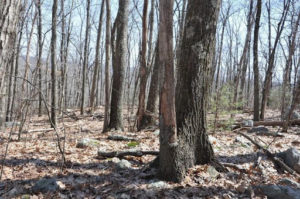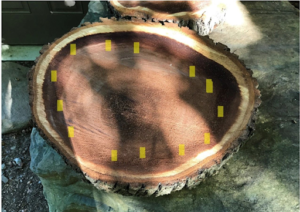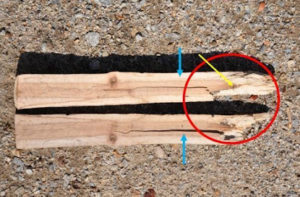The Philosophy of Tree Water Relations and Heartwood Development
By Normand Helie
This observational work and study is dedicated to my mentor Dr. Alex Shigo.
The next time you stroll through your favorite tree-lined street, park, or woods, consider yourself a part of the tree canopy. As a natural interpreter and contributor, you meditate on your surroundings. Trees need our help! Trees begin as viable seeds. They are constantly growing and changing to adapt to their environment. Put aside all preconceived ideas and thoughts on trees and soils. Consider trees as large extensions of the organic layer under your feet, which puts you right inside their strategic world.
Both forest and open-grown trees make our lives easier to live on this planet. Trees and the soil filter our two most precious resources: water and air. As water and air pass around and through trees, they alter tree growth and development. All air and water carry various elements of our earth. These elements are constantly changing due to our activities, and these activities create obstacles for the tree’s growth and development. We can help trees through this interference by knowing” how trees grow”.
Pruning deadwood out of trees is a gold standard in arboriculture around the world. Deadwood is commonly lumped into the category of diseased wood. Many standards require the elimination of all dead and diseased wood. The specification of dead and diseased wood removal is by size. Most commercial standards or contracts will request dead and diseased wood greater than 1-inch diameter be removed. Diseased wood can cause an infection into a live tree. Systemic diseases like Dutch elm disease and verticillium must be removed. Cankered and bacterial blights are also commonly removed. Eliminating diseased branches is an excellent sanitation practice in the cultural care of trees. It is believed that deadwood will cause an infection in the healthy tree. However, deadwood will not cause an infection in healthy trees. If deadwood causes infections in live trees, our forest would be in great jeopardy. The forest is filled with natural artifacts of deadwood in living healthy trees. Contrary to popular belief, deadwood offers protection and development into the tree’s soul, called heartwood.

These three mature red oaks have large co-dominant stems of aged-altered wood; this is very common in a healthy forest. These branches collect stem flow water and help recharge groundwater. The absorbed water in the aged-altered wood helps the heartwood maintain its moisture concentration. Aged-altered wood is vital for trees during prolonged dry conditions.
Deadwood is not dead. It is very passively alive and vital to the health of the entire tree. The tree will benefit from this wood that I call aged-altered wood. I use this term because the wood is highly weathered but contains protective boundaries to the heartwood as the tree grows. Aged-altered wood protects the heartwood from diseases that cause rot and decay. When aged-altered wood is removed, the protective boundary is eliminated, and the tree may be subjected to decay and rotting organisms. Trees will sometimes shed aged-altered wood naturally, but it is a prolonged process. Many times, aged-altered wood will accompany the tree for its entire life. It will only fall when there is a disturbance, and a live tree or branch rips down to the forest floor, taking with it aged-altered wood. Aged-altered wood on a healthy tree can be very dense and as strong as the heartwood in the tree’s trunk. Removing aged-altered wood from the tree will weaken the heartwood development in scaffold branches and the main trunk.
All tree twigs, branches, and trunks collect seasonal water from all forms of precipitation. This collection of water is called stem flow . As water is collected in abundance, it flows down the surface to a point on the ground. This stem flow helps groundwater recharge, especially in winter months in temperate zones. Aged-altered wood stem flow is unique. Moisture retained internally in the degrading sapwood near the heartwood is available to the tree. This internal water moves as both liquid and gas in the closed system of the tree. All the natural laws of liquid/gas movement are applied in the tree. Aged-altered wood helps the heartwood maintain a healthy moisture content (MC). MC varies throughout the seasons but is very important to early season primary plant growth and development. It provides vital embolism repair in the tops of trees and to xylem cells in the sapwood each spring. During pre-dormancy, each fall heartwood MC increases.
How Does Heartwood Develop?
Many people believe heartwood is dead and non-living. Heartwood is considered non-functional when it comes to water conductivity. Heartwood is not given consideration when it comes to water movement in trees. Water movement in a tree is both passive and dynamic. Even a cut tree, milled for homes and furniture, continues this passive activity. For example, woodworkers and painters are aware of the porosity of the wood. Optimum wood MC must be achieved before any installation and sealing operations. In living trees, aged-altered wood can collect and transfer substantially more water than a piece of lumber. More importantly, aged-altered wood on a living tree can contain the smallest amount of water. This hygroscopic water moves easily in the tree’s heartwood during prolonged periods of drought, which helps trees survive in these most difficult times. If trees do not have proper heartwood development, trees will fail to mature.
When moisture is abundant, the heartwood acts in the same manner as well-aggregated soil. Water adheres to the walls’ narrow vessels creating capillary water movement in all directions. In the heartwood of the tree, water movement is even better than in well-structured soil. I call this tree-water movement heartwood imbibition potential. The process of imbibition is well known in seed germination. A seed has enormous water-loving material that draws in water. Seed germination would fail without it. Heartwood also has imbibition potential energy. This unique moisture movement is vital for seasonal growth and development. Sapwood MC decreases in the fall as MC’s latest heartwood shells increase in the sapwood/heartwood transitional zone. As the tree transitions from sapwood and heartwood in this zone, secondary metabolites and preservatives (water-loving materials) are needed. Water is essential for this cellular modification and development.

A fall traverse cut of English elm visually reveals the moisture content in the sapwood /heartwood transitional zone (see yellow highlights). The sapwood is drier than the transitional zone. This passive seasonal water movement protects the vascular cambium from freezing in the winter. The moisture moves inward and downward to develop new heartwood. Secondary metabolites from photosynthetic production are used to form new heartwood.
This process is called heartwood formation. Heartwood formation occurs primarily in the fall but can continue into the spring months. It is an anatomical rhythmic and passive process due to water movement within the tree. Each fall, water moves from the sapwood into the heartwood. This process prevents freezing damage to the living cells of the vascular cambium and some overwintering xylem elements. Lower sapwood MC increases sugar and other organic substance concentrations to higher levels. Increasing the sugar content lowers the living cells’ freezing point in the sapwood’s vascular tissue. This cambial pre-dormancy begins when leaves begin to change color. Tree water moves inward toward the sapwood/heartwood transitional zone. Fall heartwood formation and modifications condition the tree’s ability to absorb and adsorb more water, thus increasing the heartwood imbibition potential. Imbibition moves water to the tops of the tallest trees in early spring. This anatomical and rhythmic natural process is very complex. Observation of wood MC during tree pruning and removal will help everyone understand seasonal tree water movement.
Water Is Key for All Tree Growth and Change
In early spring during the mud season, heartwood MC increases. It is common to find heartwood water flowing out of trees 60 feet high after the tree is felled in early spring. Historically, logging operations reported excessive moisture in heartwood and would not permit the logs to be transported by the river because the logs would sink to the bottom. Spring-cut trees took months to dry out even when they were correctly stacked. All spring, cut lumber was very difficult to dry out; eventually, loggers abandoned spring cutting. This water-logged condition in the heartwood is developed and maintained by spring surplus groundwater, heartwood imbibition potential, and stem flow on aged-altered wood. Understanding how water shapes, forms, and transforms trees developmentally is essential to the cultural care of trees.
After lower branches decline in the forest, water collected on the branch alters the sapwood with the help of decomposers. Sapwood is not conditioned to resist decay like heartwood. It goes through numerous seasons of erosion, feeding microorganisms in a niche environment. Water dripping from a low branch point onto the ground will increase soil microorganisms under the tree’s canopy; this creates micro-organism balance in the forest soil. Microorganisms love carbon from unconditioned cellulose in the sapwood. The heartwood in the aged-altered wood has already been modified to resist decomposing organisms. Moreover, it maintains a temporary connection to the central heartwood in the tree’s trunk and branches. No one builds a home out of sapwood! The heartwood is always used. Heartwood resists decay. As an apple is to an orchardist, the heartwood is to the forester.
In the center of the heartwood, there is tissue called pith. It is a dynamic tissue that was developed by the apical meristem when the tree was young. This pith contains parenchyma cells that may not be fully modified into heartwood. These static cells are totipotent like stem cells. These cells are numerous where the tree sets terminal or false terminal buds. When the tree is young, bud scale development creates tissue that protects the embryo in the bud. This tissue is next year’s growth. Bud scales are unique and filled with very fibrous parenchyma cells. Bud scales create the external twig scars we commonly call terminal bud scale scars. They are often used to determine a tree’s current growth rate and health. At these points in the tree’s heartwood, a protection zone can be developed by the passive activity of water in aged-altered wood. I refer to this zone as the pith protection zone.
Pith Protection Zone
The Pith Protection Zone’s origin is to protect the growing apical meristem of the young tree but, when the branch declines, it serves as a protection zone to the heartwood of the mature tree. This pith protection zone forms after the branch or stem becomes aged-altered wood. Aging wood is a process and has many stages of development. Water shapes and transforms the tree both rhythmically and passively in the whole tree. Present-day pruning standards do not utilize the pith protection zone in aged-altered wood. Premature aged-altered wood removal may cause decay and rot of the heartwood in living trees. The pith protection zone in age-altered wood should be preserved as a natural protective boundary in the living tree.

This picture is a radial dissection of aged-altered heartwood created with a band saw.
In the red circle is the complete pith protection zone. This forms during the wood aging process, but the boundary was set when the wood was growing. The yellow arrow points to the apical meristem of the tree when it was young.
The blue arrow on the top is sapwood that will eventually decay and erode, feeding microbes in the tree and on the ground. The blue arrow on the bottom is the decayed resistant heartwood. This heartwood is in close contact with the heartwood of the whole tree.
Protective boundaries should be preserved to promote heartwood formation in the tree. To do this, we must recognize the pith protection zone in aged-altered wood. As the wood ages, it weakens, beginning at the periphery of the tree’s canopy. Weakened wood becomes a safety issue with aged-altered wood in the urban environment. In normal operations, the wood is completely eliminated under current specs as dead and diseased wood. This wood is not deadwood; it is aged-altered wood. However, the risk from aged-altered wood can be disarmed by cutting back to several pith protection zones near the live branch or trunk; when pruning, consider how a tree grows annually as a small tree. Trees’ growth rates vary by species. Aged-altered wood should be left as long as possible to collect stem flow water. But the wood can be left as short as 2 to 3 feet, this will leave several pith protection zones in the aged-altered wood. Heartwood development may be negatively affected, but the pith protection zone is still intact.
Heartwood Sequesters Carbon
Heartwood formation is a carbon sequestration process. Secondary carbon metabolites are needed for heartwood formation; this process requires more than 20 times the carbon necessary for sapwood growth. The carbon addition and modification increase wood density, and there is a direct relationship between heartwood density and wood strength. The heartwood formation process condenses carbon for long-term storage. Trees rhythmically and passively transfer carbon energy into the heartwood every year. Some years, however, can be better than others. This heartwood formation is not studied because it is unseen. It is also time-consuming and complicated. The literature on heartwood formation is scarce and misguided (Evert, 2006).
Tree health and growth are commonly measured by volume. Each year a ring is formed, and this is volumetric growth. This measurement does not determine whole tree health. Heartwood development is modified annual growth that has already occurred. It does not change volumetrically. Heartwood development sequesters more carbon and is considered qualitative growth. It is extremely difficult to measure inside the tree. Only destructive sampling can determine its quality and quantity. The quantity of heartwood is measured by the ratio of heartwood developed to sapwood. Trees with higher proportions of heartwood to sapwood are healthier. I say this because heartwood formation is a function of surplus secondary metabolites at the end of each growing season. Trees with increased heartwood production and less sapwood can become more energy efficient. Increased heartwood also protects the tree and makes it stronger. Heartwood productivity is species-specific. Some species are better than others at heartwood formation. But, just as the environment affects the annual volumetric growth of sapwood, it also affects the transition of sapwood to heartwood. This sapwood/heartwood modification requires significant carbon resources from the tree’s canopy.
Protecting heartwood development by considering aged-altered wood a resource and not a disease will improve the longevity of trees in the urban environment. Arborists who serve as ambassadors for our environment should consider the pith protection zone a protective boundary for heartwood conservation. Trees are highly complex organisms, and the best of the tree’s mysteries remain in the heartwood. In urban settings, understanding “how trees grow” is vital to their productivity and preservation. Carbon sequestration is essential for our survival. More carbon is produced in our cities and rural areas; this carbon can be qualitatively stored in the heartwood of trees. Long-term carbon storage begins with proper tree care.
References and Suggested Literature
1) Esau, Katherine, 1977. Anatomy of Seed Plants 2nd ed. John Wiley & Sons Inc.
2) Evert, Ray F., 2006. Esau’s Plant Anatomy. Meristems, Cells, and Tissues of the Plant Body- Their Structure, Function, and Development 3rd ed. John Wiley & Sons Inc.
3) Shigo Alex. L., 1989. A New Tree Biology 2nd ed: facts, photos, and philosophies on trees and their problems and proper care pp 219. (1) Dr. Shigo uses the term aged-altered heartwood to contrast wound-altered heartwood. He uses the term to promote natural target pruning of live branches and the protection of the heartwood. My use of aged-altered wood is to encompass the whole natural tree and its protection of the heartwood.
4) Taylor A. M., Gartner B. L, and J. J. Morrell. 2002. Heartwood formation and Natural Durability-A Review. (2) This document lacks accuracy about water relations in trees and the process of heartwood formation. The literature on heartwood formation is very scarce. All plant growth, development, and modification require water.
Author’s Note
Cohesion-tension (CT) theory (1894) by Dixon and Joly is true in primary xylem tissue of annual plants, but it falls short in the complex water movement in trees with secondary growth and heartwood formation in so many ways. Their theory fails to explain cambial dormancy, spring embolism repair, heartwood formation, spring floral growth, and development. My seasonal sapwood/heartwood matrix theory (unpublished) can be observed during pruning and removal operations in all seasons by anyone. Simply use a wood moisture meter and follow the seasonal water movement in the living tree.
Four terms that I introduce in this article are Aged-altered wood, Stem flow, Heartwood Imbibition potential, and Pith protection zone.
About the Author
As a young boy, Norm built numerous tree forts. He would also tunnel underneath the trees, where he made many observations about how trees grow.
These simple investigations lead him into a career in arboriculture. Using scientific literature gathered from various fields, he enjoys reading about plant anatomy, nutrition, physiology and soil sciences. Taking long walks in the woods with his dog Finn helps him process this information and develop solutions to many challenges of growing trees.
***
Each author appearing herein retains original copyright. Right to reproduce or disseminate all material herein, including to Columbia University Library’s CAUSEWAY Project, is otherwise reserved by ELA. Please contact ELA for permission to reprint.
Mention of products is not intended to constitute endorsement. Opinions expressed in this newsletter article do not necessarily represent those of ELA’s directors, staff, or members.

